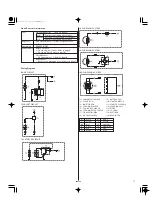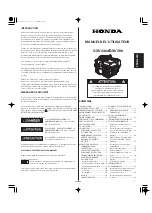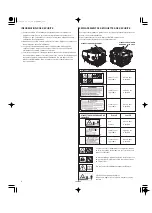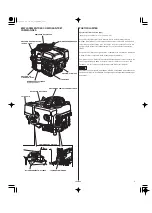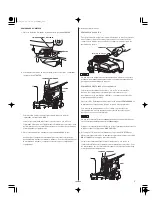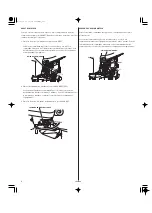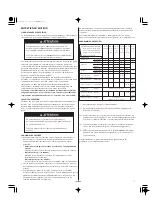
HELPFUL TIPS & SUGGESTIONS
STORING YOUR ENGINE
Storage Preparation
Cleaning
Fuel
SPARK ARRESTER (applicable types)
Spark Arrester Cleaning & Inspection
Spark Arrester Removal
ENGLISH
MUFFLER
MUFFLER PROTECTOR
SPARK ARRESTER
8 mm BOLT
GASKET
IDENTIFICATION PLATE
SPARK ARRESTER
SCREEN
5 mm SCREW (3)
8 mm NUT (2)
11
Proper storage preparation is essential for keeping your engine
trouble-free and looking good. The following steps will help to
keep rust and corrosion from impairing your engine’s function and
appearance, and will make the engine easier to start when you use
it again.
If the engine has been running, allow it to cool for at least half an
hour before cleaning. Clean all exterior surfaces, touch up any
damaged paint, and coat other areas that may rust with a light film
of oil.
Using a garden hose or pressure washing equipment can force
water into the air cleaner or muffler opening. Water in the air
cleaner will soak the air filter, and water that passes through the
air filter or muffler can enter the cylinder, causing damage.
Depending on the region where you operate your equipment, fuel
formulations may deteriorate and oxidize rapidly. Fuel
deterioration and oxidation can occur in as little as 30 days and
may cause damage to the carburetor and/or fuel system. Please
check with your servicing dealer for local storage
recommendations.
Gasoline will oxidize and deteriorate in storage. Deteriorated
gasoline will cause hard starting, and it leaves gum deposits that
clog the fuel system. If the gasoline in your engine deteriorates
during storage, you may need to have the carburetor and other
fuel system components serviced or replaced.
The length of time that gasoline can be left in your fuel tank and
carburetor without causing functional problems will vary with
such factors as gasoline blend, your storage temperatures, and
whether the fuel tank is partially or completely filled. The air in a
partially filled fuel tank promotes fuel deterioration. Very warm
storage temperatures accelerate fuel deterioration. Fuel
deterioration problems may occur within a few months, or even
less if the gasoline was not fresh when you filled the fuel tank.
Fuel system damage or engine performance problems resulting
from neglected storage preparation are not covered under the
Distributor’s Limited Warranty.
You can extend fuel storage life by adding a gasoline stabilizer
that is formulated for that purpose, or you can avoid fuel
deterioration problems by draining the fuel tank and carburetor.
Install the gasket, spark arrester, muffler, identification plate,
and muffler protector in reverse order of removal.
Use a brush to remove carbon
deposits from the spark arrester
screen. Be careful not to damage
the screen. Replace the spark
arrester if it has breaks or holes.
Remove the spark arrester from the muffler (take care not to
damage the wire mesh).
Remove the 8 mm bolt and the two 8 mm nuts, and remove the
muffler protector, identification plate, muffler and gasket from
the cylinder.
Remove the three 5 mm screws from the muffler protector.
If the engine has been running, the muffler will be hot. Allow it to
cool before servicing the spark arrester.
The spark arrester must be serviced every 100 hours to keep it
functioning as designed.
The spark arrester may be standard or an optional part, depending
on the engine type. In some areas, it is illegal to operate an engine
without a spark arrester. Check local laws and regulations. A spark
arrester is available from authorized Honda servicing dealers.
In Europe and other countries where the machinery directive
2006/42/EC is enforced, this cleaning should be done by your
servicing dealer.
1.
2.
3.
1.
2.
09/11/26 13:53:57 32Z5N610_011
Summary of Contents for GXV340
Page 19: ...09 11 26 13 56 42 32Z5N610_019 ...

















